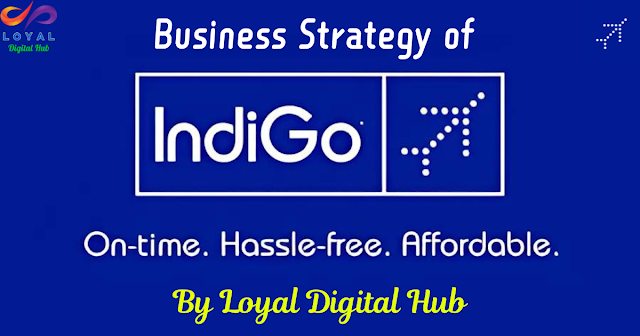IndiGo Airlines, India's largest airline by market share, has established itself as a powerhouse in the aviation industry. Known for its low-cost fares and punctuality, IndiGo’s business strategy has allowed it to dominate the market, achieving both scale and profitability in an intensely competitive environment. Let’s explore the key elements of IndiGo's business strategy and understand what makes it so successful.
1. A Relentless Focus on Low Costs
At the heart of IndiGo’s strategy is its dedication to maintaining a low-cost structure. By operating with a no-frills model, IndiGo minimizes operational expenses and passes the cost savings on to its passengers. The airline achieves this by cutting out non-essential luxuries—such as in-flight meals and entertainment—that might increase ticket prices.
Their ability to keep costs low without sacrificing quality is one of the reasons IndiGo remains a preferred airline for millions of travelers.
2. Fleet Standardization: Simplifying Operations
One of the smartest strategic decisions made by IndiGo was to standardize its fleet. The airline primarily operates Airbus A320 and A321 aircraft, which reduces the complexity and cost of maintenance, pilot training, and spare parts inventory. This uniformity across the fleet ensures efficiency in every aspect of their operations, ultimately contributing to their low-cost model.
3. Operational Efficiency and Turnaround Time
IndiGo is famed for its punctuality, a key selling point in a market where delays are often common. The airline has mastered the art of quick turnaround times, ensuring that planes spend more time flying and less time on the ground. High aircraft utilization means better revenue generation per aircraft, contributing to overall profitability.
4. Point-to-Point Connectivity
Rather than relying on a hub-and-spoke model like many full-service carriers, IndiGo follows a point-to-point route system. This means passengers are flown directly between destinations without layovers. Not only does this cut down on travel time, but it also reduces airport charges, which helps keep ticket prices low.
5. Fuel Efficiency: Modern Fleet and Hedging
Fuel is one of the largest costs for any airline, but IndiGo has found ways to minimize this expense. By maintaining a modern, fuel-efficient fleet, IndiGo reduces its fuel consumption. Additionally, the airline uses fuel hedging strategies to lock in prices and protect itself against price volatility, providing more stability to their cost structure.
6. Expanding Market Presence
IndiGo’s strategy of penetrating both major cities and underserved regions has allowed it to capture a significant portion of India’s growing middle-class market. With the airline offering affordable connectivity to Tier 2 and Tier 3 cities, it has expanded its market reach, providing air travel opportunities to passengers who previously relied on other modes of transportation.
IndiGo is also increasing its international footprint, gradually expanding to nearby international destinations and forging partnerships with global airlines through code-sharing agreements.
7. Strong Financial Discipline
Financial discipline is a cornerstone of IndiGo’s strategy. Despite rapid expansion, the airline has maintained a strong balance sheet. By controlling costs, keeping debt manageable, and ensuring strong cash reserves, IndiGo is well-prepared to weather financial storms and economic downturns.
8. Revenue Diversification: Ancillary Services
In addition to ticket sales, IndiGo has tapped into several ancillary revenue streams, such as charging for seat selection, baggage, in-flight meals, and priority boarding. These additional services contribute significantly to the airline’s profitability without raising the base fare, making it a win-win situation for both the airline and passengers.
9. Customer Experience: Simple Yet Efficient
While IndiGo focuses on being a low-cost carrier, it does not compromise on the basics of customer satisfaction. From an easy-to-use booking platform to well-maintained aircraft, IndiGo ensures a smooth and hassle-free flying experience for its passengers. The airline's reputation for punctuality, cleanliness, and reliability has become a key part of its brand identity.
10. Adapting to Changing Market Conditions
IndiGo’s resilience was on full display during the COVID-19 pandemic. The airline swiftly adjusted to the crisis by scaling down operations, renegotiating leases, and introducing cargo services to mitigate losses. IndiGo’s ability to adapt and make swift decisions has allowed it to emerge stronger from challenging situations.
FAQs About IndiGo Airlines’ Business Strategy
1. How does IndiGo maintain its low-cost advantage?
IndiGo maintains a low-cost advantage by adopting a no-frills model, standardizing its fleet, outsourcing non-core functions, and optimizing fuel efficiency. This allows it to keep operational costs low and offer competitive ticket prices.
2. Why does IndiGo use a point-to-point network instead of a hub-and-spoke system?
The point-to-point network enables IndiGo to avoid unnecessary layovers and reduce airport fees, which helps keep costs low and improves the airline’s on-time performance.
3. What role does fleet standardization play in IndiGo's strategy?
Fleet standardization simplifies pilot training, maintenance, and spare parts management. IndiGo’s decision to operate primarily Airbus A320s allows the airline to streamline its operations and reduce costs.
4. How does IndiGo manage fuel price volatility?
IndiGo employs fuel hedging strategies to lock in fuel prices and protect itself against price fluctuations. Additionally, it operates a modern, fuel-efficient fleet to minimize fuel consumption.
5. How important is customer satisfaction to IndiGo?
Customer satisfaction is vital to IndiGo’s success. While it focuses on keeping costs low, the airline ensures a reliable and punctual flying experience, which has become a key part of its brand reputation.
6. What are IndiGo's future growth plans?
IndiGo aims to expand its international presence, penetrate new domestic markets, and continue adding modern, fuel-efficient aircraft to its fleet. The airline is also exploring more code-sharing agreements with global carriers.
Conclusion
IndiGo Airlines’ business strategy is a carefully balanced combination of cost efficiency, operational excellence, and market penetration. By focusing on affordability, punctuality, and maintaining a simple yet effective approach to operations, IndiGo has captured the hearts of millions of travelers. As the airline continues to expand both domestically and internationally, its commitment to financial discipline and customer satisfaction remains central to its success.





0 Comments